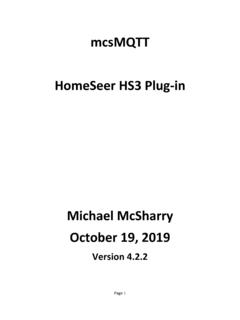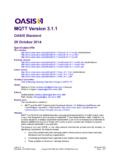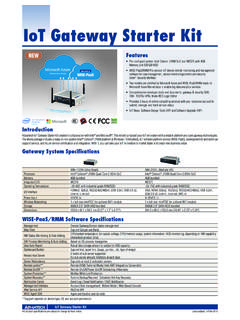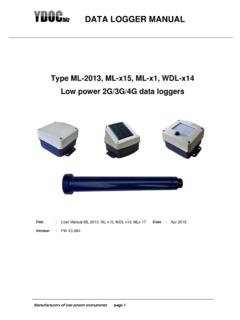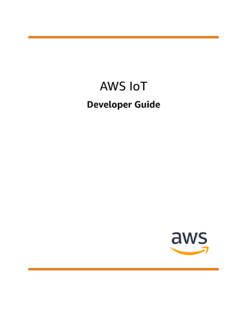Transcription of Benchmark of MQTT servers - Scalagent - Accueil
1 Benchmark ofMQTT serversActiveMQ (based on Joram )Mosquitto Queue Telemetry Transport ( mqtt ) is an open Machine-to-Machine (M2M) protocol, that has been invented in 1999, and that has become an OASIS standard1. mqtt is a lightweight event and message oriented protocol allowing devices to asynchronously and efficiently communicate across constrained networks to remote systems. mqtt is now becoming one of the standard protocols for the Internet of Things (IoT).The mqtt protocol relies on a messaging server following the hub and spoke model of Message Oriented Middleware (MOM). As shown in Figure 1, every mqtt client, data processing application or device, producer or consumer, needs to connect to a central server before communicating with other mqtt clients.
2 The server accepts published messages and delivers them to the interested consumers according to a Publish/Subscribe interaction goal of the Benchmark is to evaluate the scalability of an mqtt server with the number of clients. The term scalability refers to the ability of the server to handle a growing number of clients. This Benchmark does not add more nodes or resources (CPU, memory) to make the server scale, either horizontally or vertically. The server is launched on a single node with fixed test bench allows to check that in a given context (QoS level, message throughput per client, message payload size), the server scales with the number of , at Scalagent , aimed at designing an objective Benchmark of the different mqtt servers .
3 The evaluation of the servers is made according to a simple and realistic test scenario, and the comparison is presented in terms of basic measurements (CPU, latency, message rates) with a detailed description of the conditions in which they have been obtained and how the different servers have been 1: hub and spoke modelThe following servers have been evaluated (alphabetical order): ActiveMQ Apollo JoramMQ (based on Joram ) Mosquitto RabbitMQ configuration of every server is the default one with few modifications detailed in section scenarioThe test scenario is called multi-publisher . It simulates a large number of devices, for example smart meters, publishing telemetry data connected with a command centre. The devices are the publishers and the command centre is the are structured as a 3-level tree.
4 The top level represents the system, for example an electrical distribution circuit with a single power substation. The level below is called subsystem . In the metering use case, a subsystem would be the access point in the neighbourhood that enables the meters to reach Internet and publish data to the electricity company. An example of access point is an antenna mounted on a utility pole. The bottom level is the device, a smart 3-level tree is mapped to an mqtt topic hierarchy. A fourth topic level is added below the devices to represent the telemetry parameters, for example the power consumption (kWh).An mqtt topic is just a hierarchical name, for example: System/Subsystem/Device/Parameter Figure 2 represents the different levels of the topic hierarchy applied to the metering use 2: mqtt topic hierarchy for the metering use caseThe multi-publisher scenario described above is executed in the test environment represented in Figure 3.
5 The mqtt server is launched as a single instance on a single device is represented by an mqtt client, called publisher that creates an mqtt connection3 and publishes messages to its topics, the topics representing the telemetry parameters of the topics are organized in partitions in order to have independent test instances producing and consuming messages through a dedicated topic hierarchy. In this way the load can be increased by simply adding new test instances, executed in several processes, and on several machines. Each test instance should not be directly affected by the other test instances. They should all run command centre is represented by several mqtt clients, called subscribers . One subscriber is created for every topic partition.
6 A connection is opened and a subscription is made to the root topic of the partition, the topic representing the System level as explained instances are launched on two machines, each instance handling 1000 publishers4 and 1 subscriber5. The ratio 1/1000 happens to be the most convenient to evaluate the performance of the various servers . The total number of parameter topics per partition is scalability tests launching the mqtt server on several nodes see the document at: mqtt connection is created for every publisher, connections are not shared between test environment does not allocate one thread per publisher in order to minimize the CPU load. Samples of messages (100) are asynchronously published by a single thread through a given number of publishers (1000) in a round-robin way at a fixed rate (one sample every 100 ms).
7 5 Subscribers are activated by threads managed by the mqtt client 3: test environmentThe goal of the Benchmark is to evaluate the impact of the number of publishers on every mqtt server , in terms of the delivered throughput (message rate on the subscriber side), the CPU usage of the server , and the time required to transmit a message from a publisher to a subscriber, the message transmission latency. There should be no limitation caused by the clients (affecting each other) or by the topic partition is made of: 1 root topic System 10 topics Subsystem 100 topics Device per subsystem 10 topics Parameter per deviceIn the metering use case, a topic partition represents an electrical distribution circuit with 1000 meters, each meter publishing 10 telemetry scalability of the server with the number of clients is evaluated by incrementally increasing the number of test instances.
8 The scalability test starts with a minimum of 2000 publishers and 2 subscribers, and tries to reach a maximum of publishers and 100 publishers send messages at a steady rate. The tests do not try to reach the maximum message throughput. The goal is to show how the server scales with the number of publishers, each publishing at a fixed message rate is set to 1 message per second per publisher. In this way the number of publishers (and connections) also gives the global message throughput, for example publishers produce messages per second through mqtt message payload size is fixed and set to 64 bytes. This payload size is small but makes sense in the metering use case as every message transmits a single telemetry parameter. Such a small size has been chosen in order not to overwhelm the server memory, limited to 3 GB, either directly (memory allocation for every message) or indirectly (TCP buffer size).
9 However, a future version of this Benchmark will test several payload is tested by assigning the same QoS level to publishers and provides three QoS levels: QoS level 0, also called at most once , which means that messages may be delivered once or not at all. QoS level 1, also called at least once , ensures that the messages arrive at the receiver at least once. QoS level 2, also called exactly once because messages are neither lost or QoS levels 0 and 1 have been tested. QoS 2 will be tested in a next version of this QoS 0, mqtt publishers send messages and forget about them. No acknowledgement is returned by the server and the message is not persistently QoS 1, mqtt publishers expect an acknowledgement after having sent a message.
10 Moreover the server should make the message persistent before delivering it and before the acknowledgement is returned to the publisher. The message has to be really written to disk and not only flushed to the OS level 1 is only tested with durable subscriptions, subscriptions that enqueue messages in a persistent way. mqtt uses a flag called Clean Session to specify a durable subscription. If Clean Session is false, then the subscription is tests check that there is no message loss, even at QoS level 3 machines used for the Benchmark have the same configuration listed in the table hereafter. The CPU and memory resources are limited to only two cores and 4 GB RAM. The network bandwidth is ensured by a Gigabit switch.
